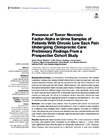| dc.contributor.author | Gevers-Montoro, Carlos | |
| dc.contributor.author | Romero-Santiago, Mar | |
| dc.contributor.author | Losapio, Lisa | |
| dc.contributor.author | Conesa-Buendía, Francisco Miguel | |
| dc.contributor.author | Newell, Dave | |
| dc.contributor.author | Álvarez-Galovich, Luis | |
| dc.contributor.author | Piché, Mathieu | |
| dc.contributor.author | Ortega-De Mues, Arantxa | |
| dc.date.accessioned | 2023-03-08T15:27:42Z | |
| dc.date.available | 2023-03-08T15:27:42Z | |
| dc.date.issued | 2022-04-12 | |
| dc.identifier.citation | Gevers-Montoro, C., Romero-Santiago, M., Losapio, L., Conesa-Buendía, F. M., Newell, D., Álvarez-Galovich, L., & Mues, O. D. (2022). Presence of Tumor Necrosis Factor-Alpha in urine samples of patients with chronic low back pain undergoing chiropractic care: preliminary findings from a prospective cohort study. Frontiers in Integrative Neuroscience. https://doi.org/10.3389/fnint.2022.879083 | en |
| dc.identifier.issn | 1662-5145 | |
| dc.identifier.uri | https://aecc.archive.knowledgearc.net/handle/123456789/179 | |
| dc.description | Available under License - Create Commons Attribution: https://creativecommons.org/licenses/by/4.0/ | en |
| dc.description.abstract | Background and aims: Low back pain is the leading cause of years lived with disability worldwide. Chiropractors employ different interventions to treat low back pain, including spinal manipulative therapy, although the mechanisms through which chiropractic care improves low back pain are still unclear. Clinical research and animal models suggest that spinal manipulation might modulate plasma levels of inflammatory cytokines, which have been involved in different stages of low back pain. More specifically, serum levels of Tumor Necrosis Factor-alpha (TNF-α) have been found to be elevated in patients with chronic low back pain. We aimed to investigate whether urine from chronic low back pain patients could be an appropriate medium to measure concentrations of TNF-α and to examine possible changes in its levels associated to chiropractic care.
Methods: Urine samples were collected from 24 patients with chronic low back pain and TNF-α levels were analyzed by ELISA before and after 4–6 weeks of care compared to a reference value obtained from 5 healthy control subjects, by means of a Welch’s t-test. Simultaneously, pain intensity and disability were also evaluated before and after care. Paired t-tests were used to compare mean pre and post urinary concentrations of TNF-α and clinical outcomes.
Results: Significantly higher baseline levels of urinary TNF-α were observed in chronic low back pain patients when compared to our reference value (p < 0.001), which were significantly lower after the period of chiropractic treatment (p = 0.03). Moreover, these changes were accompanied by a significant reduction in pain and disability (both p < 0.001). However, levels of urinary TNF-α were not correlated with pain intensity nor disability.
Conclusion: These results suggest that urine could be a good milieu to assess TNF-α changes, with potential clinical implications for the management of chronic low back pain. | en |
| dc.language.iso | en | en |
| dc.publisher | Frontiers in Integrative Neuroscience | en |
| dc.subject | Low back pain | en |
| dc.subject | Inflammatory cytokines | en |
| dc.subject | Urinalysis | en |
| dc.subject | Tumor necrosis factor alpha | en |
| dc.subject | Chronic pain | en |
| dc.subject | Chiropractic | en |
| dc.title | Presence of Tumor Necrosis Factor-Alpha in urine samples of patients with chronic low back pain undergoing chiropractic care: preliminary findings from a prospective cohort study | en |
| dc.type | Article | en |
| dc.identifier.doi | https://doi.org/10.3389/fnint.2022.879083 | |
